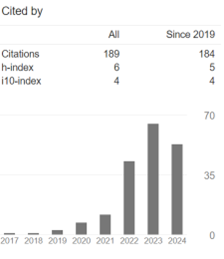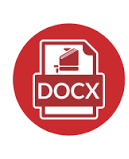PEMANFAATAN GOOGLE SEBAGAI SUMBER INFORMASI UTAMA KARYA TULIS
Abstract
Abstract: Primary sources of information are needed to support arguments and theories as basic tools to help discover the truth about people, events, and problems in research or written work. Google search engines and their derivatives are believed to make it easier to find quality main information sources. Providing better, more relevant results, allows Google to be considered a reliable resource for finding information on the web. However, it takes knowledge and skills in finding quality information and using google search engines properly. Knowledge of the main source with related aspects such as the characteristics of the main source, the advantages and disadvantages of the main source, the types of which should not be denied. Skills in searching for quality information and using google search engines and the decrease in skills that must be honed continuously so that it becomes a skill that integrates with the search for main source information. Considering that online information sources on Google, especially those on Google Books, are often incomplete, searchers can find them on various free sites that provide books, as well as articles searched for on Google Shoolar are often paid, they can also be found on the site. free site, but the role that is no less important is the library must provide sources of information needed by information seekers who are their clients
Keyword: Utilization of Google, Writing, Library
Abstrak: Sumber informasi utama dibutuhkan mendukung argument dan teori sebagai alat dasar untuk membantu menemukan kebenaran tentang orang, peristiwa, dan masalah dalam penelitian atau karya tulis. Google search engine dan turunannya diyakini dapat memudahkan menemukan sumber informasi utama berkualitas. Memberikan hasil yang lebih baik, lebih relevan, memungkinkan Google dianggap sebagai sumber yang dapat dipercaya untuk menemukan informasi di web. Namun, dibutuhkan pengetahuan dan ketrampilan dalam menemukan informasi yang berkualitas dan menggunakan google search engine secara baik. Pengetahuan mengenai sumber utama dengan aspek terkait seperti karateristiks sumber utama, Kelebihan dan kekekurangan Sumber Utama, jenis-jenis meruapakah yang tidak boleh dinafikan. Keterampilan dalam menelusuri informasi yang berkualitas dan menggunakan google search engine dan turunanya juga keterampilan yang mesti diasah terus menerus sehingga menjadi ketrampilan yang menyatu dengan penulusuran informasi sumber utama. Mengingat sumber informasi online yang ada di google terutama yang ada di google book yang sering tidak utuh, maka penelusur bisa mendapatkannya di berbagai situs gratis yang menyediakan buku, demikian juga artikel yang ditelusur di google shoolar sering berbayar, maka juga dapat ditemukan di situs situs gratis, namun peran yang tidak kalah pentingya adalah perpustakaan harus menyediakan sumber informasi untuk yang dibutuhkan oleh pencari informasi yang menjadi klien mereka
Kata Kunci: Pemanfaatan Google, Karya Tulis, Perpustakaan
Full Text:
PDFReferences
Bass, H. (2007). Creating Award-Winning History Fair Projects:
The Complete Handbook for Teachers, Parents, and Students.
PRUFROCK PRESS INC....
Allen, M. (Ed.). (2017). The SAGE en-cyclopedia of
communication re-search methods. Sage Publica-tions.hal.1575
Ameen, A. A. K. (2017). Scholarly communication in the age of
Google: Exploring academics’ use patterns of e-journals at the
University of the Punjab. The Electronic Library, 35(1), 167-184.
American Library Association. (2000). Information literacy
competency standards for higher education.
American Library Association. (2008). Presidential committee on
information literacy. http://www. ala.
org/ala/acrl/acrlpubs/whitepapers/presidential. cfm.
Anderson, M. A. (2012). Google Literacy Lesson Plans: Way
beyond‗ Just Google It ‘‖. Internet@ Schools, 19(4), 20-22.
Bahde, A., Smedberg, H., & Taormina, M. (Eds.). (2014). Using
Primary Sources: Hands-On Instructional Exercises: Hands-On
Instruc-tional Exercises. ABC-CLIO.hal.xix
Bahde, A., Smedberg, H., & Taormina, M. (Eds.). (2014). Using
Primary Sources: Hands-On Instructional Exercises: Hands-On
Instruc-tional Exercises. ABC-CLIO.hal.xix
Bates, M. J. (1979). Information search tactics. Journal of the
American Society for information Sci-ence, 30(4), 205-214.
Belk, R. W. (Ed.). (2007). Handbook of qualitative research
methods in marketing. Edward Elgar Pub-lishing.hal.72
Brodber, K. S., & Kasmally-Dwarika, A. (2016). CXC Study
Guide: Communications Studies for CAPE®. Oxford University
Press-Children.34
Bronshteyn, K., & Tvaruzka, K. (2008). Using Google Scholar at
the reference desk. Journal of library administration, 47(1-2),
-124.
Choi, J. H. (2016). Considering Core Ideas of ACRL Information
Literacy'Framework (2015)'. Journal of the Korean Society for
Library and Information Science, 50(3), 171-191.
Cox, S. A. (2014). Managing information in organizations: A
practical guide to implementing an information management
strategy. Macmillan International Higher Education.hal270
Craver, K. W. (1997). Teaching elec-tronic literacy: a concepts-
based approach for school library media specialists. Libraries
Unlim-ited.hal.152
Craver, K. W. (1999). Using internet primary sources to teach
critical thinking skills in history. Green-wood Publishing Group.hal.15
CRESWELL, J. W. (2020). Educational Research: Planning,
Conducting, and Eval-uating Quantitative and Qualita-tive...
Research, Global Edition. PEARSON EDUCATION LIM-ITED.
Efron, S. E., & Ravid, R. (2018). Writing the literature re-view: A
Practical Guide. Guil-ford Publications.hal .59
Glazer, E. (2001). Using internet pri-mary sources to teach
critical thinking skills in mathematics. Greenwood Publishing
Group.hal.27
Gliner, J. A., Morgan, G. A., & Leech, N. L. (2011). Research
methods in applied settings: An integrated approach to design
and analysis. Routledge.hal.32
Grogg, J. E., & Ashmore, B. (2007). Google Book Search libraries
and their digital copies. Searcher (Medford, NJ), 15(4).
Grudzina, Douglas and Kolba, Boris (2008) Writing an A Research
Paper: A Roadmap for Beginning and Experienced Writers. Prest-
wick House, Inc. hal,44hal,44
Harper, S. F. (2016). Google books review. Journal of Electronic
Resources in Medical Libraries, 13(1), 2-7.
Harris, R. (1997). Evaluating Internet research sources. Virtual
salt, 17(1), 1-17.
Haven, K. F. (2000). Super simple storytelling: a can-do guide for
every classroom, every day. Libraries Unlimited.hal.82
Higgs, J., Letts, W., & Crisp, G. (Eds.). (2019). Education for
employability (Volume 2): Learning for future possibilities.
BRILL.hal.40
Hirsh, S. (Ed.). (2018). Information services today: An
introduction. Rowman & Littlefield.hal.121
Hoffmann, A. L. (2016). Google books, libraries, and self-respect:
Information justice beyond distributions. The Library Quarterly,
(1), 76-92.
http://www2.lawrence.edu/fast/revieg/acminfolit/acrl.html
https://www.lib.uts.edu.au/guides/primary-sources/primary-
sources/strengthsweakness, diakses 29-6-2020
https://www.statista.com/statistics/216573/worldwide-market-
share-of-search-engines/diakses 26-6-2020
Johns, N., & Lee-Ross, D. (1998). Research methods in service
industry management. Cengage Learning EMEA.
Johnson, R. B., & Christensen, L. (2019). Educational research:
Quantitative, qualitative, and mixed approaches. SAGE Publi-
cations, Incorporated.
Kousha, K., & Thelwall, M. (2009). Google book search: Citation
analysis for social science and the humanities. Journal of the
American Society for Information Science and Technology, 60(8),
-1549.
Kousha, K., & Thelwall, M. (2020). Google Books, Scopus,
Microsoft Academic and Mendeley for impact assessment of
doctoral dissertations: A multidisciplinary analysis of the UK.
Quantitative Science Studies, 1-26.
Levy, J., & Keller, S. (2015). A Prima-ry Source Investigation of
the Al-amo. The Rosen Publishing Group, Inc.hal.4
Markey, K. (2019). Online Searching: A guide to finding quality
infor-mation efficiently and effectively. Rowman &
Littlefield.hal.250
Orcher, L. T. (2016). Conducting re-search: Social and behavioral
science methods. Routledge.
Scanlon, M., Daugman, E., Keener, M., Lock, M. B., &
Makaravage, E. (2013). Research Like a Librari-an: Accessing
Information in the 21st Century.
Singh, G. (2013). Information sources, services and systems. PHI
Learn-ing Pvt. Ltd..
Smallwood, C. (Ed.). (2015). The complete guide to using Google
in libraries: instruction, admin-istration, and staff productivity
(Vol. 1). Rowman & Little-field.hal.53
Van Rys, J., Meyer, V., & Sebranek, P. (2011). The Research
Writer, Spi-ral bound Version. Cengage Learning.hal.34
VanderMey, R., Meyer, V., Van Rys, J., & Sebranek, P. (2014).
The college writer: A guide to think-ing, writing, and researching.
Cengage Learning.hal.448
Whitley, B. E., & Kite, M. E. (2013). Principles of research in
behavioral science. Routledge.hal.123
Writing an A Research Paper: A Roadmap for Beginning and Ex-
perienced Writers.hal,44
Zientek, L. R., Werner, J. M., Campuzano, M. V., & Nimon, K.
(2018). The use of Google Scholar for research and research
dissemination. New Horizons in Adult Education and Human
Resource Development, 30(1), 39-46.
Grudzina, Douglas and Kolba, Boris (2008)Writing an A Research
Paper: A Roadmap for Beginning and Experienced Writers Pear-
son Education Limited..hal,44
Hepworth, M., & Walton, G. (Eds.). (2013). Developing people's
information capabilities: fostering information literacy in
educational, workplace and community contexts. Emerald Group
Publishing.hal.53
https://www.towermarketing.net/blog/google-best-search-en-
gine/#:~:text=It's%20believed%20that%20Google's%20success
,quali-
ty%20results%20for%20each%20user.&text=Google%20provide
s%20simple%2C%20better%20results,the%20user%20will%20b
e%20happy. 26-6-2020
DOI: https://doi.org/10.15548/jib.v4i1.62
Refbacks
- There are currently no refbacks.
Copyright (c) 2020 Jurnal Imam Bonjol : Kajian Ilmu Informasi dan Perpustakaan

This work is licensed under a Creative Commons Attribution 4.0 International License.
Alamat: Kampus I Universitas Islam Negeri (UIN) Imam Bonjol Padang - Pascasarjana, Jalan Jenderal Sudirman No.15, Padang Pasir, Padang Barat, Kp. Jao, Kec. Padang Bar., Kota Padang, Sumatera Barat 25153
Email: admin@journal.pustakauinib.ac.id pustakapusatuinib@gmail.com



